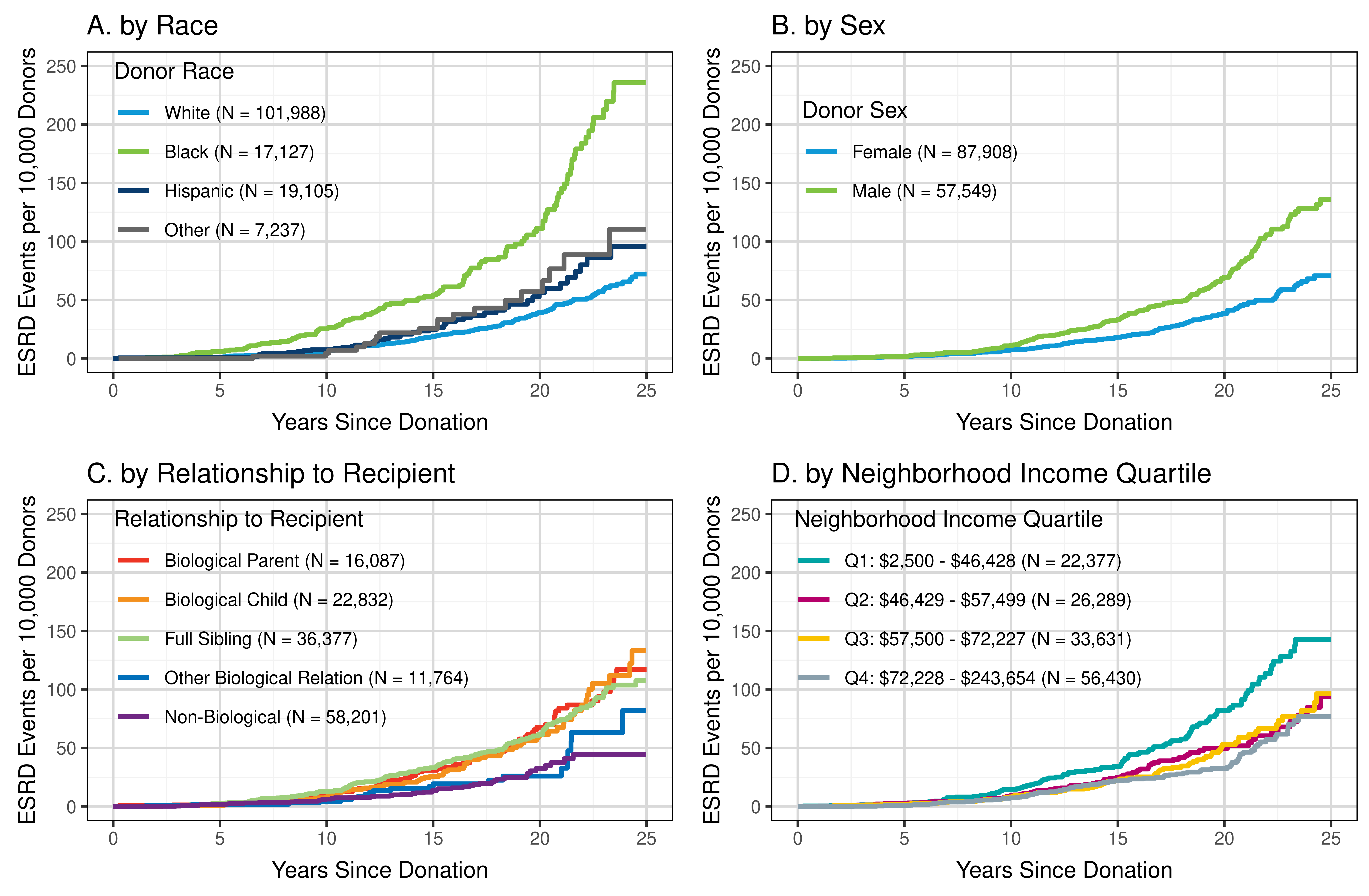25-Year Risk of ESRD Among Living Kidney Donors
1Research, UNOS, Richmond, VA, 2Office of the Chief Medical Officer, UNOS, Richmond, VA
Meeting: 2022 American Transplant Congress
Abstract number: 95
Keywords: Kidney, Living donor, Outcome, Renal failure
Topic: Clinical Science » Kidney » 39 - Kidney Living Donor: Long Term Outcomes
Session Information
Session Name: Kidney Living Donor: Long Term Outcomes
Session Type: Rapid Fire Oral Abstract
Date: Sunday, June 5, 2022
Session Time: 5:30pm-7:00pm
 Presentation Time: 5:30pm-5:40pm
Presentation Time: 5:30pm-5:40pm
Location: Hynes Room 206
*Purpose: Previous research on post-donation ESRD in living kidney donors (LKDs) has been limited by short follow-up time, the small number of ESRD cases available for analyses, and data linkage challenges.
*Methods: We studied 25-year risk of post-donation ESRD in LKDs who donated in the U.S. 4/1/1994-3/31/2020 (n=145,457), ascertaining ESRD with OPTN and CMS data (Table 1). 381 LKDs developed ESRD through 3/31/2020. We calculated cumulative incidence of ESRD via Kaplan-Meier methodology, both overall and by donor sex, race, relationship, and SES.
*Results: The overall cumulative incidence of ESRD 25 years post-donation was 98.1 per 10,000 LKDs. Group differences 25 years after donation were of much greater magnitude than those found at 20 years post-donation in previous research, and results supported the hypothesis that rates of ESRD among LKDs would follow the exponential pattern seen in the general population. Most notably, cumulative incidence for Black LKDs increased from 111.3 at 20 years to 235.7 at 25 years, with less pronounced increases for other groups (white: 39.1 to 72.2, Hispanic: 56.2 to 95.7, other: 57.0 to 110.4; Figure 1a). Male LKDs’ cumulative incidence increased substantially – from 69.4 at 20 years to 136.0 at 25 years, with a smaller increase for female donors (38.4 to 70.7; Figure 1b). We found similar effects for first-degree relatives of the recipient (full sibling: 61.3 at 20 years to 107.6 at 25 years; parent: 67.7 to 117.2; child: 61.6 to 133.1; Figure 1c) and for LKDs in the lowest quartile of neighborhood income (Q1: 82.3 at 20 years to 142.8 at 25 years; Figure 1d).
*Conclusions: These findings further inform risk assessment of potential LKDs and illustrate the importance of continuing to quantify long-term ESRD risk.
| ESRD | No ESRD | |
| n = 381 | n = 145074 | |
| Sex | ||
| Female | 165 (43.3%) | 87742 (60.5%) |
| Male | 216 (56.7%) | 57332 (39.5%) |
| Race | ||
| White | 196 (51.4%) | 101792 (70.2%) |
| Black | 120 (31.5%) | 17006 (11.7%) |
| Hispanic | 46 (12.1%) | 19059 (13.1%) |
| Other | 19 (5%) | 7217 (5%) |
| Age at Donation (median (IQR)) | ||
| 38.0 (30.0-50.0) | 41.0 (32.0-50.0) | |
| Relationship to Recipient | ||
| Parent | 73 (19.2%) | 16014 (11%) |
| Child | 73 (19.2%) | 22759 (15.7%) |
| Full Sibling | 156 (40.9%) | 36221 (25%) |
| Other Blood Relation | 21 (5.5%) | 11743 (8.1%) |
| Non-Biological | 57 (15%) | 58144 (40.1%) |
| Missing | 1 (0.3%) | 193 (0.1%) |
| BMI at Donation (median (IQR)) | ||
| 28.9 (25.0-31.6) | 26.6 (23.7-29.7) | |
| eGFR at Donation (CKD-epi; median (IQR) | ||
| 96.9 (81.5-108.2) | 97.6 (84.4-110.0) | |
| Median Neighborhood Income | ||
| Q1: $2,500 – $46,428 | 107 (28.1%) | 22270 (15.4%) |
| Q2: $46,429 – $57,499 | 69 (18.1%) | 26220 (18.1%) |
| Q3: $57,500 – $72,227 | 79 (20.7%) | 33552 (23.1%) |
| Q4: $72,228 – $243,654 | 102 (26.8%) | 56328 (38.8%) |
| Missing | 24 (6.3%) | 6704 (4.6%) |
| Age at ESRD Onset (median (IQR)) | ||
| 53.0 (44.0-62.0) | NA | |
| Years from Donation to ESRD Onset (median (IQR)) | ||
| 14.3 (10.1-18.8) | NA |
To cite this abstract in AMA style:
Wainright J, Robinson A, Wilk A, Klassen D, Cherikh W, Stewart D. 25-Year Risk of ESRD Among Living Kidney Donors [abstract]. Am J Transplant. 2022; 22 (suppl 3). https://atcmeetingabstracts.com/abstract/25-year-risk-of-esrd-among-living-kidney-donors/. Accessed December 26, 2025.« Back to 2022 American Transplant Congress

